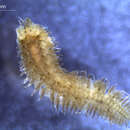Gattyana cirrhosa: Brief Summary
(
anglais
)
fourni par wikipedia EN
Gattyana cirrhosa is a scale worm known from widespread locations in the North Atlantic, Arctic, and northwestern Pacific oceans, from the intertidal zone to depths of at least 1,200 m (3,900 ft).
- licence
- cc-by-sa-3.0
- droit d’auteur
- Wikipedia authors and editors
Gattyana cirrhosa
(
russe
)
fourni par wikipedia русскую Википедию
Латинское название
Gattyana cirrhosa (Pallas, 1766)[1] Синонимы
-
Aphrodita cirrhosa Pallas, 1766 (basionym)
-
Aphrodita filamentosa Bruguiere, 1789
-
Aphrodita punctata Fabricius, 1780
-
Aphrodita scabra Fabricius, 1780
-
Aphrodita viridis Montagu, 1815
-
Gattyana cirrosa (Pallas, 1766)
-
Gattyana imbricata Treadwell, 1926
-
Harmothoe scabra (Fabricius, 1780)
-
Lepidonotus cirratus parasiticus Baird, 1865
-
Nychia cirrosa (Pallas, 1766)
-
Nychia cirrosa chaetopteri Malaquin, 1890
-
Polynoe scabriuscula Sars, 1861

Систематика
на Викивидах

Поиск изображений
на Викискладе
ITIS 64478 NCBI 862912 Gattyana cirrhosa (лат.) — вид морских многощетинковых червей семейства Polynoidae из отряда Phyllodocida[2].
Описание
Встречаются на глубинах от литоральных илистых грунтов до 1000 м в водах Северного Ледовитого океана, северной части Тихого океана и северной Атлантики, включая проливы Скагеррак и Каттегат и Северное море. Длина тела до 50 мм, включает до 38 сегментов[3]. На простомиуме три пары антенн (Polynoinae) и глаза на омматофорах. Перистомальные усики с циррофорами. Простомиум разделён медиальным желобком на две части. Параподии двуветвистые. Все щетинки (сеты) простые [2][4][5]. Часто обнаруживается в пустых трубках других полихет например, Amphitrite, Chaetopterus, Thelepus или вместе с мшанками Melobesia и Amphihelia. Один их самых обычных для северных морей вид полихет семейства Polynoidae[6].
Примечания
-
↑ Pallas, Peter Simon. 1766. Miscellanea Zoologica, quibus noví imprimis atque obscurí animalium species describuntur et observationibus iconibusque illustrantur. Petrum van Cleef. Hagí Comitum.
-
↑ 1 2 WoRMS — World Register of Marine Species: Kroh, A.; Hansson, H. (2012). Gattyana cirrhosa. In: Read, G.; Fauchald, K. (2012) World Polychaeta database.
-
↑ species-identification.org
-
↑ Fauchald, K. 1977. The polychaete worms, definitions and keys to the orders, families and genera. Natural History Museum of Los Angeles County: Los Angeles, CA (USA) Science Series 28:1-188.
-
↑ nhm.ac.uk: Polynoidae
-
↑ Жирков И. А. Полихеты Северного Ледовитого Океана. — М.: Янус-К, 2001. — 631 с.
- licence
- cc-by-sa-3.0
- droit d’auteur
- Авторы и редакторы Википедии
Gattyana cirrhosa: Brief Summary
(
russe
)
fourni par wikipedia русскую Википедию
Gattyana cirrhosa (лат.) — вид морских многощетинковых червей семейства Polynoidae из отряда Phyllodocida.
- licence
- cc-by-sa-3.0
- droit d’auteur
- Авторы и редакторы Википедии
Biology
(
anglais
)
fourni par World Register of Marine Species
Breeding probably takes place in spring (March-June) and the larvae develop in the water column. The species spawns several times during its life. It can reach an age of at least 4-5 years. In the subtidal parts of the area, G. cirrhosa is almost exclusively found in the tubes of the polychaete Chaetopterus variopedatus. Other studies have recorded the species from (empty) tubes of other polychaetes such as Lagis koreni and Amphitrite johnstoni, and in Arenicola burrows. G. cirrosa, like all polynoids, is considered a predatory carnivore. Small crustaceans, echinoderms, polychaetes, gastropods, sponges and hydroids have been mentioned as prey items. (Hartmann-Schröder, 1971; Wolff, 1973; Curtis, 1977; Fauchald & Jumars, 1979; Hayward & Ryland, 1990).
Holtmann, S.E.; Groenewold, A.; Schrader, K.H.M.; Asjes, J.; Craeymeersch, J.A.; Duineveld, G.C.A.; van Bostelen, A.J.; van der Meer, J. (1996). Atlas of the zoobenthos of the Dutch continental shelf. Ministry of Transport, Public Works and Water Management: Rijswijk, The Netherlands. ISBN 90-369-4301-9. 243 pp.
- licence
- cc-by-4.0
- droit d’auteur
- WoRMS Editorial Board
Distribution
(
anglais
)
fourni par World Register of Marine Species
This species is very abundant at the Oyster Ground, where it forms a substantial part of the infaunal biomass. G. cirrhosa also occurs in the Delta area (Grevelingenmeer, Ooster- and Westerschelde). The species is (almost) absent from the Southern Bight and the Wadden Sea.
Holtmann, S.E.; Groenewold, A.; Schrader, K.H.M.; Asjes, J.; Craeymeersch, J.A.; Duineveld, G.C.A.; van Bostelen, A.J.; van der Meer, J. (1996). Atlas of the zoobenthos of the Dutch continental shelf. Ministry of Transport, Public Works and Water Management: Rijswijk, The Netherlands. ISBN 90-369-4301-9. 243 pp.
- licence
- cc-by-4.0
- droit d’auteur
- WoRMS Editorial Board
Habitat
(
anglais
)
fourni par World Register of Marine Species
G. cirrhosa shows a preference for the muddier types of sediment as found in the Oyster Ground.
Holtmann, S.E.; Groenewold, A.; Schrader, K.H.M.; Asjes, J.; Craeymeersch, J.A.; Duineveld, G.C.A.; van Bostelen, A.J.; van der Meer, J. (1996). Atlas of the zoobenthos of the Dutch continental shelf. Ministry of Transport, Public Works and Water Management: Rijswijk, The Netherlands. ISBN 90-369-4301-9. 243 pp.
- licence
- cc-by-4.0
- droit d’auteur
- WoRMS Editorial Board
Morphology
(
anglais
)
fourni par World Register of Marine Species
This species has a flattened body that is oval in outline. lt is composed of up to 38 segrnents and reaches 40 mm in length. The dorsal surface is covered with fifteen pairs of soft scales (elytra). These elytra are covered with minute spines and have a fringe of papillae along the outer edge. The head bears four eyes, one median and two lateral antennae. The elytra have a distinct dark spot in the centre (Hartmann-Schröder, 1971; Hayward & Ryland, 1990).
Holtmann, S.E.; Groenewold, A.; Schrader, K.H.M.; Asjes, J.; Craeymeersch, J.A.; Duineveld, G.C.A.; van Bostelen, A.J.; van der Meer, J. (1996). Atlas of the zoobenthos of the Dutch continental shelf. Ministry of Transport, Public Works and Water Management: Rijswijk, The Netherlands. ISBN 90-369-4301-9. 243 pp.
- licence
- cc-by-4.0
- droit d’auteur
- WoRMS Editorial Board


![]()